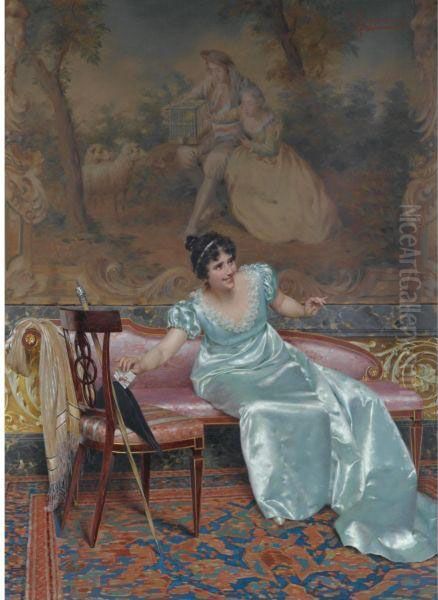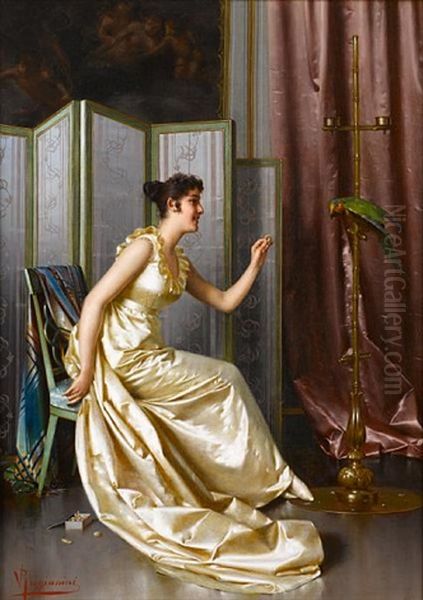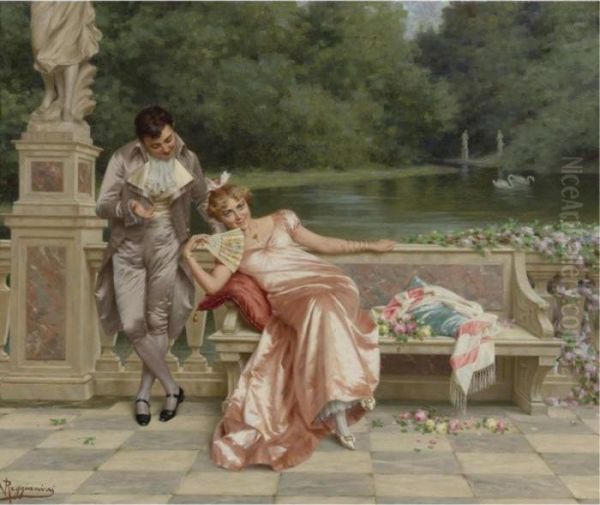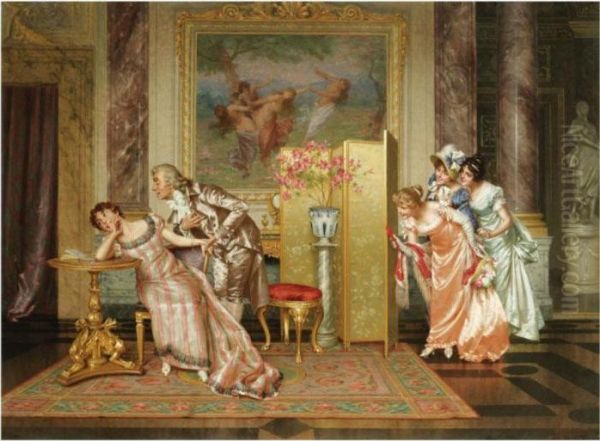Vittorio Reggianini stands as a prominent figure in late 19th and early 20th-century Italian art, celebrated for his exquisite genre paintings that capture the opulent and idealized lifestyle of the European upper-middle class. An artist firmly rooted in the Academic Classical tradition, Reggianini developed a distinctive style characterized by meticulous detail, vibrant colour, and a romanticized vision of domestic life. His works, often depicting elegant women, playful children, and scenes of courtship within lavish interiors, continue to charm audiences with their technical brilliance and nostalgic portrayal of a bygone era.
Early Life and Academic Foundations
Born in Modena, Italy, in 1858, Vittorio Reggianini's artistic journey began in his hometown. He enrolled at the Accademia di Belle Arti di Modena (Academy of Fine Arts of Modena), where he received rigorous training in the principles of academic art. This education emphasized draughtsmanship, anatomical accuracy, perspective, and the study of Old Masters, providing him with a strong technical foundation that would underpin his entire career. His talent was recognized early, and after completing his studies, he even served as a professor at the same institution, demonstrating his mastery of the academic curriculum he himself had followed.
This period of study and teaching in Modena instilled in Reggianini a deep appreciation for craftsmanship and precision. The academic system, dominant across Europe at the time, valued polished finishes, clear compositions, and subjects that were often historical, mythological, or, in Reggianini's case, elegantly rendered scenes of contemporary or near-contemporary life. His early works likely reflected these academic standards, honing the skills necessary to capture likeness, texture, and complex interior spaces.
Florence: A New Artistic Chapter
In 1885, seeking broader opportunities and a more vibrant artistic environment, Reggianini made a pivotal move to Florence. This city, a historical heart of the Italian Renaissance, remained a significant cultural and artistic centre in the late 19th century, attracting artists and patrons from across Europe and America. Florence offered a stimulating atmosphere, access to influential galleries, and a community of artists working in similar veins. It was here that Reggianini truly established his reputation and developed the signature style for which he is best known.

The move to Florence proved crucial for Reggianini's career. He immersed himself in the city's artistic life, likely studying its rich artistic heritage while also connecting with contemporary trends and markets. Florence was a hub for genre painting, particularly scenes catering to the tastes of the wealthy bourgeoisie and international tourists who desired sophisticated, decorative works depicting idealized beauty and luxury. Reggianini adeptly tapped into this demand, refining his focus on elegant interior scenes.
The Academic Tradition and Genre Painting
Reggianini operated firmly within the Academic tradition, a style that dominated official European art institutions for much of the 19th century. Academic art prioritized technical skill, adherence to established conventions of composition and representation, and often drew inspiration from classical antiquity or the Renaissance. While movements like Impressionism, spearheaded by artists such as Claude Monet and Pierre-Auguste Renoir, were challenging these norms with their focus on light, colour, and modern life rendered with looser brushwork, Academic painting maintained considerable prestige and market appeal.
Reggianini specialized in genre painting – scenes of everyday life. However, his "everyday" was a highly selective and embellished one, focusing almost exclusively on the leisured activities of the affluent. His work aligns with a specific subgenre popular during the Belle Époque (roughly 1871-1914), which celebrated elegance, luxury, and refinement. Artists like the Belgian Alfred Stevens and the French James Tissot explored similar themes of modern high society, though often with different nuances. Reggianini's particular contribution was his intensely detailed, almost jewel-like rendering of these scenes, often infused with a nostalgic, slightly historical flavour.
Reggianini's Signature Style: The "Costume Painter"
Reggianini earned the moniker "Costume Painter," a term reflecting his extraordinary ability and dedication to rendering fabrics, clothing, and interior décor with astonishing precision. His canvases luxuriate in the textures of silk, satin, velvet, and lace. Gowns are depicted with an almost tactile quality, their folds catching the light, their intricate patterns meticulously detailed. This focus was not merely decorative; it was integral to creating the atmosphere of opulence and refinement that defined his work.
His interiors are equally elaborate, featuring gilded furniture often in Louis XV or Louis XVI revival styles, ornate mirrors, plush carpets, polished parquet floors, delicate porcelain, and arrangements of fresh flowers. Every element is rendered with careful attention, contributing to a sense of richness and sensory delight. Reggianini employed a smooth, highly finished technique, leaving brushstrokes largely invisible, which further enhanced the illusionistic quality of his paintings and aligned with academic ideals of craftsmanship. His use of colour was typically bright and harmonious, adding to the cheerful and untroubled mood of his scenes.
Themes and Subjects: A World of Elegance

The world depicted in Reggianini's paintings is one of grace, leisure, and gentle sentiment. His most frequent subjects are elegantly attired women, often shown engaged in quiet activities: reading letters, arranging flowers, playing musical instruments like the mandolin or piano, or simply conversing in sumptuously decorated drawing rooms. These women embody an ideal of refined femininity prevalent in the era.
Children also feature prominently, usually portrayed as cherubic and well-behaved, playing with pets or interacting gently with adults. Scenes of courtship are another common theme, depicting demure flirtations and romantic exchanges, often imbued with a sense of playful innocence. Narrative is often implied rather than explicit – a dropped handkerchief, a shared glance, a half-read letter – inviting the viewer to imagine the story behind the scene. The overall atmosphere is consistently light, charming, and devoid of hardship or social commentary, presenting an idealized fantasy of upper-class existence.
Notable Works and Recurring Motifs
While a definitive catalogue raisonné might be complex due to the similarity of themes, several works and types of scenes are representative of Reggianini's output. His painting titled Tristis Mater Nata Presagina Finis (roughly translating to "The Sad Mother Foreseeing the End for her Child"), exhibited in 1900 at the prestigious Alinari gallery in Florence, suggests a departure towards a more melancholic or symbolic theme, though still likely rendered with his characteristic elegance. This title stands out among his more typically lighthearted subjects.
More characteristic are works often titled descriptively, such as The Love Letter, a theme he revisited frequently. These paintings typically show one or more beautifully dressed women in a luxurious interior, reacting to the contents of a letter, evoking curiosity and romance. Feeding the Parrot is another example, showcasing his skill in depicting not only human figures and fabrics but also the textures of feathers and the interaction between humans and pets within a domestic setting.
An Illicit Love hints at a slightly more complex narrative, perhaps a secret rendezvous or forbidden affection, adding a layer of intrigue while maintaining the elegant aesthetic. Reading an Art Journal reflects the cultural pursuits of the class he depicted, showing figures engaged with the world of art itself. Across his oeuvre, recurring motifs include musical instruments, letters, flowers, pets (parrots, lapdogs), and opulent decorative objects, all rendered with his signature meticulousness.
Contemporaries and Connections: The Florentine Circle

Reggianini was not working in isolation. He was part of a thriving community of artists in Florence who specialized in similar types of highly finished, decorative genre scenes, often catering to the same international clientele. He had particularly close ties, both stylistically and possibly personally, with artists like Federico Andreotti and Francesco Vinea. Their works often share striking similarities in subject matter, composition, the use of specific props, and even models, suggesting a collaborative or mutually influential environment.
Another key figure is Arturo Ricci (1854-1919), who, along with his father Pio Ricci, produced works very much in the same vein as Reggianini – detailed, colourful scenes of 18th-century-inspired aristocratic life, full of courtship and charming anecdote. The French-born but Italian-active painter Frédéric Soulacroix (often confused with his father Charles Soulacroix) also created highly polished scenes of elegant figures in luxurious settings, sharing Reggianini's penchant for depicting shimmering silks and satins.
Beyond this immediate circle, Reggianini's work can be compared to other European painters specializing in historical or contemporary costume pieces. Cesare Auguste Detti, another Italian, painted lively historical genre scenes, often set in earlier centuries. While different in subject, the emphasis on detailed costumes and settings provides a point of comparison. The broader context includes successful Academic painters like William-Adolphe Bouguereau in France, known for his idealized figures, or Jean-Léon Gérôme, famous for his historical and Orientalist scenes, demonstrating the widespread appeal of highly finished, technically brilliant painting during this period. Even the Venetian genre scenes of Antonio Ermolao Paoletti share a focus on charming, everyday life, albeit in a different regional setting.
Exhibitions and Recognition
Reggianini actively sought recognition through participation in exhibitions. His showing of Tristis Mater Nati Presea Presagius Finis at the Alinari exhibition in Florence in 1900 was a significant event, placing his work in a prominent commercial and critical venue. He also participated in exhibitions organized by the Società delle Belle Arti di Firenze (Florence Fine Arts Society) in the years 1907-08 and 1910-11. These exhibitions were important platforms for artists to showcase their latest works, gain critical notice, and attract patrons.
His consistent participation in such shows indicates his integration into the formal art world of Florence and his success in maintaining visibility. The popularity of his chosen genre, combined with his undeniable technical skill, ensured a steady demand for his paintings, particularly among affluent Italian buyers and foreign visitors on the Grand Tour circuit or residing in Florence. His reputation was built on delivering exquisitely crafted visions of elegance and romance.
Later Life and Enduring Legacy

Vittorio Reggianini continued to paint in his established style until his death in 1938. He witnessed dramatic shifts in the art world, with modernism challenging and eventually eclipsing the dominance of Academic art in critical discourse. However, the appeal of his work persisted, particularly among collectors who valued traditional craftsmanship and charming subject matter.
Today, Reggianini's paintings remain highly sought after in the art market, often commanding high prices at auction. While art history has often prioritized avant-garde movements, there is a renewed appreciation for the technical mastery and cultural significance of Academic painters like Reggianini. His work offers a fascinating window into the tastes and aspirations of the Belle Époque bourgeoisie, capturing an idealized vision of life characterized by luxury, leisure, and refined sentiment. He stands as a master of his specific genre, a painter who perfected the art of depicting elegance.
Conclusion: Chronicler of Opulence
Vittorio Reggianini carved a distinct niche for himself within the landscape of late 19th and early 20th-century European art. As an Italian Academic painter based primarily in Florence, he became a leading exponent of the elegant genre scene. Dubbed a "Costume Painter" for his extraordinary attention to the details of fabric, fashion, and furnishings, he created idealized portrayals of upper-middle-class life. His works, filled with graceful women, charming children, and romantic encounters set within lavish interiors, offer a potent blend of technical virtuosity and nostalgic charm. While not an innovator in the modernist sense, Reggianini was a master craftsman whose paintings continue to captivate viewers with their beauty, detail, and evocative portrayal of Belle Époque elegance.